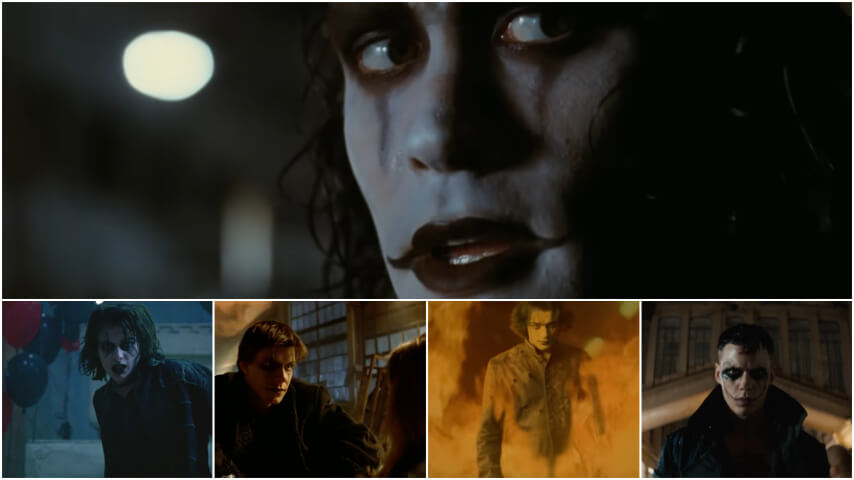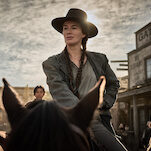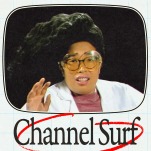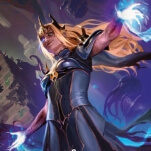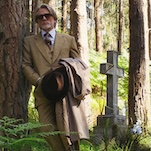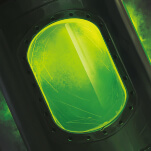The Crow was a big hit for Dimension, enough to warrant a sequel despite Lee’s death. The film’s true shepherd, legendary producer Edward R. Pressman, operated under the belief that sequels shouldn’t be direct continuations. As long as the new Crow wasn’t Eric Draven, The Crow: City Of Angels (1996) could fly. Enter Swiss actor Vincent Pérez, who plays Ashe Corven, the first in a series of awful Crow aliases. This name comes from the twisted mind of David S. Goyer, the film’s only credited screenwriter, writing his first script in a superhero genre he would dominate. Not that you’d be able to tell from the movie.
The Crow: City Of Angels is one of the ugliest studio movies of the ‘90s. It looks like it was filmed inside a piss-filled toilet bowl. The sickly greens and urine yellows are of a piece with Mark Romanek’s “Closer” music video and David Fincher’s Alien3. Director Tim Pope, another music video director, crafted a sister city to Proyas’ Detroit, a hellish Los Angeles that’s all extreme angles and brutal physicality. Unfortunately, the film was made by the Weinsteins, an experience that, in Pope’s words, “put me off making films for 20 years.” They took the film from Pope during post-production (“Half the story was taken away,” Pope recalls, “as they instructed editors to replicate the first story with flashbacks.”) and released a director’s cut, which Pope did not approve. It doesn’t make a lick of sense.
Heightening the narrative from a fiancée’s rape and murder, Goyer writes Corven as a father who watches his young son bound, gagged, and shot for witnessing a gangland murder. Dumped into the harbor by drug kingpin Judah Earl (Richard Brooks), The Crow finds his way back to earth with the help of an adult Sarah (Mia Kirshner), now a sex worker living in another of The Crow’s miserable cities, and returns for another stylish killing spree. While the story more or less plays out as a variation of the last one, Goyer does introduce some key new ideas. For instance, Corven doesn’t know he’s dead and spends much of the film screaming and crying in agonizing pain, haunted by memories of his son’s killing.
It’s hard to blame Goyer or Pope for City Of Angels’ foibles. The movie is deeply compromised, and it shows. Like Alien3, missing pieces hint at a fuller experience that will never come. No one suffers more than Pérez, who gets thrown under the bus as the new Crow, replacing a beloved dead star only two years later. The movie is enjoyed best as a bit of incoherent expressionism, with freaky bad guys, a singular style, and a miserable tone that few movies could compete with. By 1996, superhero movies were already a waning interest, but City Of Angels is a superhero film in the broadest terms. It’s a grotesque grindhouse art movie in complete touch with the anger and misery of its character and production. Though City Of Angels now has its defenders, the reviews at the time were harsh, and the box office was worse.
Poor ticket sales and reviews never stopped Ed Pressman, though, who hired Rob Zombie to direct a third installment, The Crow: 2037. But after 18 months, Zombie walked, citing the indecisiveness and “schizophrenic” behavior of the producers. Pressman and co-producer Jeff Most replaced Zombie with British director Bharat Nalluri to make a younger, cleaner, and supposedly hotter Crow.
This would become The Crow: Salvation (2000), a stylistic departure for the series. Abandoning the comic’s narrative spine, Salvation introduces us to Alex Corvis (Eric Mabius, whose real name would’ve done just fine), an innocent man given the chair for the murder of his girlfriend. Struck by lightning as the executioner flips the switch, he returns as the Crow to solve the mystery, clear his name, and kill the bastards responsible. Kirsten Dunst stands in for Sarah as the Crow’s assistant. Dunst is the sister of Corvis’ dead love and the original dickless asshole William Atherton is her obviously guilty father.
Of the films, Salvation is most tonally at odds with its scale and story. Far less visually ambitious than its predecessors, Salvation occurs in poorly lit offices, garages, and alleyways. Half the movie happens in Atherton’s office, where Dunst interrogates him over her sister’s murder, but Nalluri never finds anything particularly visually or dramatically stimulating. The film looks like your standard direct-to-video Dimension release, with dusty, dingy photography and cheap, underpopulated locations. The Crow’s chiaroscuro lighting evoked the dreary worldview of its source material. Salvation is simply underlit.
Aside from a brief encounter with a young Walton Goggins, there’s not much to Salvation. Mabius never elicits the same ethereal charisma of Lee nor the resurrection angst of Pérez. The first Crow to find himself fourth-billed in the cast, Mabius barely registers during the credits, let alone the film. Audiences certainly didn’t clock him. Dimension dumped Salvation on video in 2000. With Scream and, later, Scary Movie, Dimension had learned to vertically integrate its blockbusters, and The Crow franchise would join the From Dusk Till Dawn sequels on the direct-to-video rack. That didn’t mean The Crow was dead, just that budgets would get much tighter. And by tighter, we mean non-existent.
The Crow: Wicked Prayer (2005) is a movie where the whole budget is on screen—all $96. Initially set up for DMX to star, which sounds infinitely more interesting than the film we got, The Crow: Lazarus would fall apart just as 2037 did. In its stead, Pressman secured Edward Furlong for a Crow that feels more indebted to other Dimension movies than James O’Barr.
Directed by Lance Mungia, Wicked Prayer builds on the Western grindhouse mashups of Robert Rodriquez. Mungia, who made a minor genre splash with the post-apocalyptic martial arts spaghetti Western Six String Samurai, seemed a good fit. Set in the ghost towns and trailer parks of the Raven Aztec reservation, Wicked Prayer follows recently paroled Jimmy Cuervo (Furlong), out for revenge against the Satanic motorcycle cult led by Luc “Death” Crash (David Boreanaz, whose agent clearly couldn’t get him out of this) and Lola Byrne (Tara Reid, in her element) for plucking out his fiancée’s eyes and tossing her and Jimmy in the dump.
Wicked Prayer’s most formidable and least-served element is its cast, particularly Boreanaz. Asked to play Actual Satan, he can’t even muster the malevolence of his best Buffy arcs. Part of that is due to the budget, which likely didn’t allow for many takes. How else can we explain scenes like this:
Surprisingly, Furlong wears the goth uniform much more comfortably than his predecessor. Smaller than previous Crows, Furlong plays to the frustrations and limitations of life after incarceration. If you squint, you can see Pérez’s pain and Lee’s lithe sexuality in Furlong’s performance. Of course, this is offset by a scene where a man named Death serves a blood-soaked sheet cake to his lackeys, “War,” “Famine,” and “Pestilence.”
Despite its budgetary restrictions, Wicked Prayer is a welcome variation of The Crow mythos, transforming from a neo-noir revenge thriller to a bordertown Western. Furlong looks excellent in his corpse paint, perhaps the thickest in the series, as the movie plays up his short stature, allowing him to be a slinky and scummy lead. He’s taking the role seriously, too, despite spending much of the film awkwardly riding a children’s bicycle through the desert. It’s a shame the movie couldn’t support him.
Again regulated to DVD, Wicked Prayer barely made a blip, and The Crow began a nearly two-decade return to the screen. Though the property passed through numerous hands, Rupert Sanders’ reboot The Crow (2024) doesn’t bear the marks of a tortured production. Surprisingly, it’s the most coherent adaptation yet, marking several significant firsts for the franchise. It’s the first to make Shelly (FKA Twigs) an actual character instead of a saintly fridged wife shown only in rose-colored flashbacks. Sanders is also the first to make some semblance of sense of the series’ squishy mythology.
Bill Skarsgård stars as Eric Draven, a recovering addict who falls in love with fugitive misfit Shelly in rehab. On the run from a malevolent patron of the arts, Vincent Roeg (Danny Huston), she has a video of his demonic powers in action, and he does not want to get canceled. In the film’s first half, we actually spend time in Eric and Shelly’s relationship. From their cafeteria meet-cute to Shelly’s graphic suffocation, The Crow leans into the couple’s passion, hammering their codependent nature and deep connection. It’s time well spent, as screenwriters Zach Baylin and William Josef Schneider find some unturned stones in the mythos, focusing on the theme of unconditional love and the depths of Eric’s devotion.
However, Sanders shaves down O’Barr’s aesthetic, stripping The Crow of its ‘80s goth visuals in search of something more contemporary. The film’s steely cinematography and jaw-splitting violence reflect a more modern interpretation. There’s plenty of bird-brained mysticism, but Eric’s world hues closer to ours. Even the more fantastical elements don’t showcase the more visually lavish aspects of the series. Case in point: The Crow’s spiritual purgatory is an abandoned trainyard, an unimaginative location for the character’s magical aviary.
Sanders’ film is pretty conventional by Crow standards—though it still reflects an outsider status. The 2024 adaptation looks more like pre-MCU superhero fare á la Constantine than a contemporary franchise entry. It’s also the most audience-minded of the five, bringing in a mentor character to help make sense of the Crow’s convoluted backstory. It’s a tired trope that feels like a late addition, but at least someone is answering this guy’s questions.
The Crow can handle a little convention, just as it can handle a little artfulness. No matter what Dimension and Edward Pressman threw at The Crow, the series always found a way to resurrect. Neither tragedy nor vanishing budgets nor a changing culture could stop the character from crawling from his grave time and time again. Yet, The Crow’s gothic vibe and striking makeup have remained on the fringes of our culture as a relic of the ‘90s; the pro wrestler Sting has been wearing the Crow corpse paint since 1996, and retired in full Crow makeup earlier this year. The Crow’s cult status still hinges on the ‘94 film, specifically its soundtrack, which is the perfect accouterment to the grunge and goth revival of the last few years. Studios like Dimension and Lionsgate will always try to wring a few dollars out of the character, but show little faith in him while doing so. Given the reboot’s shrug of a release, the character’s popularity may have died with Lee. Maybe that’s best. The Crow works best as a post-punk tone poem for misfits who don’t relate to the billionaire heroics of Iron Man and Batman. The Crow bottles the angst of adolescence and the thrill of the macabre, not a righteous sense of duty. He’s earned his cult. After all, goths need a superhero, too.
Outside canon: The Crow: Stairway To Heaven, a one-season syndicated TV series with deep Pink Opaque vibes, makes for a serviceable and toned-down Crow. Starring Mark Desancos of Iron Chef America, the series spends its first five episodes remaking the original film before exploring its monster-of-the-week potential. It also allows The Crow to face real-world problems, like paying rent. It’s a fun, light Saturday afternoon version of The Crow, made in the mold of Buffy The Vampire Slayer. It also ranks among the best work of the whole franchise.
Final ranking:
1. The Crow (1994)
2. The Crow: City Of Angels (1996)
3. The Crow (2024)
4. The Crow: Wicked Prayer (2005)
5. The Crow: Salvation (2000)
